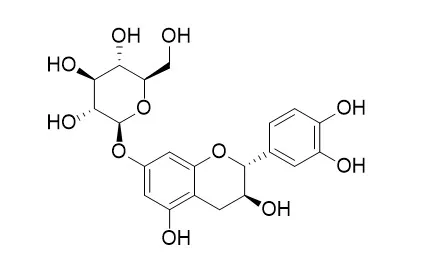| In vitro: |
| Cell Biochem Funct . 2010 Dec 2;28(8):651-660. | | Cytoprotective effects of catechin 7-O-β-D glucopyranoside against mitochondrial dysfunction damaged by streptozotocin in RINm5F cells[Pubmed: 21104932] | | The protective effects of catechin 7-O-β-D glucopyranoside (C7G) against streptozotocin (STZ)-induced mitochondrial damage in rat pancreatic β-cells (RINm5F) were investigated. A marked increase in mitochondrial reactive oxygen species (ROS) was observed in STZ-treated cells; this increase was restricted by C7G treatment. C7G also scavenged superoxide anions and hydroxyl radicals generated by xanthine/xanthine oxidase (xanthine/XO) and the Fenton reaction (FeSO(4) + H(2) O(2)), respectively. C7G restored activity and expression of both mitochondrial manganese superoxide dismutase (MnSOD) and catalase (CAT), which were suppressed by STZ treatment. In addition, C7G prevented STZ-induced mitochondrial lipid peroxidation, protein carbonyl, and DNA base modification. C7G restored the loss of mitochondrial membrane potential (Δψ) that was disrupted by STZ treatment, and prevented cell death via inhibition of apoptosis. These results suggest that C7G has a protective effect against STZ-induced cell damage by its antioxidant effects and the attenuation of mitochondrial dysfunction. | | J Food Sci . 2019 Nov;84(11):3172-3178. | | Isolation and Characterization of Antihyperglycemic Compounds from Vigna angularis Extracts[Pubmed: 31613007] | | Functional foods that inhibit α-amylase and α-glucosidase activity are effective for regulating the blood glucose level and preventing hyperglycemia. Extracts of adzuki beans (ABs, Vigna angularis), widely eaten in East Asia, can inhibit α-amylase and α-glucosidase activity. In this study, we identified and evaluated the components in an AB water extract (ABWE) after boiling, which is an essential process for cooking ABs. The ABWE before boiling inhibited α-amylase and α-glucosidase activity and the boiled ABWE showed slightly stronger inhibitory effects. High-performance liquid chromatography, liquid chromatography-mass spectrometry, and nuclear magnetic resonance analyses identified (+)-catechin 7-O-β-d-glucopyranoside (C7G), (+)-epicatechin 7-O-β-d-glucopyranoside (E7G), and (+)-catechin as the bioactive components in boiled ABWE. Interestingly, the quantity of E7G significantly increased after boiling (from 0% to 17.1 ± 1.3%). E7G showed stronger inhibition of α-amylase and α-glucosidase than C7G; the IC50 values for α-amylase were 0.74 ± 0.04 mg/mL (C7G) and 0.40 ± 0.09 mg/mL (E7G), and for α-glucosidase the IC50 values were 0.085 ± 0.032 mg/mL (C7G) and 0.051 ± 0.007 mg/mL (E7G). Our findings suggest that C7G and E7G are the main active components in ABWE as they inhibit α-amylase and α-glucosidase and their inhibitory effect is not lost after boiling. These results support the effectiveness of boiled ABs in the promotion of health. PRACTICAL APPLICATION: We identified (+)-catechin 7-O-β-d-glucopyranoside (C7G), (+)-epicatechin 7-O-β-d-glucopyranoside (E7G), and (+)-catechin in adzuki bean extracts and commercially available boiled adzuki bean products. Interestingly, the E7G content was increased by boiling, and this compound showed strong inhibitory activity toward α-amylase and α-glucosidase. These results support the consumption of boiled adzuki beans to prevent acute rises in blood glucose level. | | Planta Med . 2008 Dec;74(15):1800-1802. | | Flavan-3-ols from Ulmus davidiana var. japonica with inhibitory activity on protein glycation[Pubmed: 18991204] | | Four flavan-3-ols, (+)-catechin ( 1), (+)-catechin 7- O- beta- D-apiofuranoside ( 2), (+)-catechin 7- O- beta- D-xylopyranoside ( 3), (+)-catechin 7- O- beta- D-glucopyranoside ( 4), and proanthocyanidin A-1 ( 5) as well as three other constituents, isolated from an EtOAc-soluble extract of the stem barks of Ulmus davidiana var. japonica, were evaluated for inhibitory activity against the formation of AGEs. Compounds 1 - 5 exhibited a significant inhibitory activity on the formation of AGEs in an AGEs-BSA assay by specific fluorescence and this was confirmed by an indirect AGEs-ELISA. Moreover, compounds 1 and 5 markedly reduced AGEs-BSA cross-linking to collagen in a dose-dependent manner. AGEs:advanced glycation end products BSA:bovine serum albumin CC:column chromatography CD:circular dichroism. |
|
| In vivo: |
| Int Immunopharmacol . 2015 Dec;29(2):521-527. | | Catechin-7-O-β-D-glucopyranoside isolated from the seed of Phaseolus calcaratus Roxburgh ameliorates experimental colitis in rats[Pubmed: 26453508] | | The seeds of Phaseolus calcaratus Roxburgh (PHCR) are common legumes that comprise part of the daily diet in Chinese and Korean culture. Recent findings highlight anti-inflammatory and anti-septic potentials of catechin-7-O-β-D-glucopyranoside (CGP) isolated from PHCR seeds. We investigated the intestinal anti-inflammatory activity and associated mechanisms of CGP using a rat model of trinitrobenzenesulfonic acid (TNBS)-induced colitis. Oral treatment with CGP (10mg/kg body weight) suppressed body weight loss and intestinal inflammatory damages in TNBS-induced colitic rats. This treatment reduced myeloperoxidase activity and malondialdehyde level, but increased glutathione level in the TNBS colitic rats. CGP treatment also inhibited the TNBS-mediated increases in nitric oxide synthase, cyclooxygenase-2, interleukin-1β, tumor necrosis factor-α, intercellular adhesion molecule-1, and monocyte chemotactic protein-1 proteins or mRNA levels. This inhibition was accompanied by the increased mRNA levels of mucins MUC2 and MUC3. The CGP treatment prevented phosphorylation of p38 mitogen-activated protein kinase, IκB-α, and DNA-nuclear factor-κB binding, all of which were increased in the inflamed colons of TNBS-treated rats. Furthermore, oral administration with a crude PHCR butanol extract (100mg/kg body weight) which contains 1.5% of CGP showed intestinal anti-inflammatory potentials similar to that of CGP. Collectively, our current findings suggest that CGP or CGP-containing PHCR seeds may have favorable effects on intestinal inflammatory diseases. |
|






 Cell. 2018 Jan 11;172(1-2):249-261.e12. doi: 10.1016/j.cell.2017.12.019.IF=36.216(2019)
Cell. 2018 Jan 11;172(1-2):249-261.e12. doi: 10.1016/j.cell.2017.12.019.IF=36.216(2019) Cell Metab. 2020 Mar 3;31(3):534-548.e5. doi: 10.1016/j.cmet.2020.01.002.IF=22.415(2019)
Cell Metab. 2020 Mar 3;31(3):534-548.e5. doi: 10.1016/j.cmet.2020.01.002.IF=22.415(2019) Mol Cell. 2017 Nov 16;68(4):673-685.e6. doi: 10.1016/j.molcel.2017.10.022.IF=14.548(2019)
Mol Cell. 2017 Nov 16;68(4):673-685.e6. doi: 10.1016/j.molcel.2017.10.022.IF=14.548(2019)